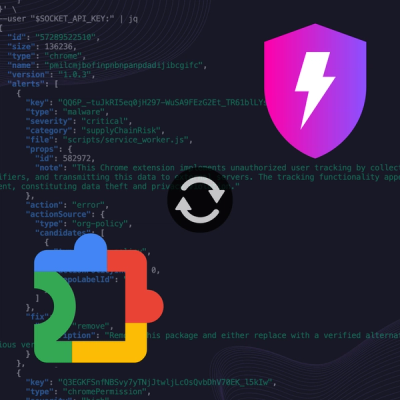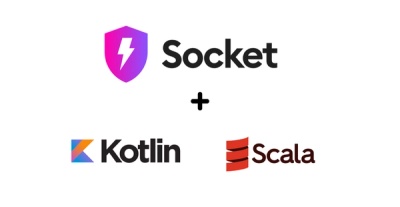
Product
Socket Now Protects the Chrome Extension Ecosystem
Socket is launching experimental protection for Chrome extensions, scanning for malware and risky permissions to prevent silent supply chain attacks.
Overview
Testing
Documentation
Installation
Usage
Contributing
References
This is a library for making requests to a Canvas LMS API.
This project is tested with tox.
Run the tox command to run checks and unit tests:
$ tox
By default, this project's tox runs:
To create test coverage reports:
$ tox -e cov
Deployment to pypi is done with tox:
$ tox -e deploy
Make sure to bump the version in setup.py before deploying.
This project has Sphinx documentation at the following url:
https://lcary.github.io/canvas-lms-tools/
The public Canvas LMS API documentation is also very useful:
https://canvas.instructure.com/doc/api/index.html
To install, use pip:
pip install canvas_api_client
Or clone the repo:
git clone https://github.com/lcary/canvas-lms-tools.git
cd canvas-lms-tools/canvas_api_client
python setup.py install
Adding the client as a dependency in your project's requirements.txt
file is the intended way to use the client.
$ python
>>> from canvas_api_client.v1_client import CanvasAPIv1
>>> url = 'https://my.canvas.instance.com/api/v1/'
>>> token = '1396~xxxxxxxxxxxxxxxxxxxTHISxISxNOTxAxREALxTOKENxxxxxxxxxxxxxxxxxxxxx'
>>> api = CanvasAPIv1(url, token)
>>> l = api.get_account_blueprint_courses('1234')
>>> for r in l.json():
... print(r['id'], r['name'])
...
49400 Course_9000_Blueprint
57600 Spring_2018_Blueprint
This very simple example requires a few environment variables. The API URL and token should be something like:
CANVAS_API_URL=https://my.canvas.instance.com/api/v1/
CANVAS_API_TOKEN=1396~xxxxxxxxxxxxxxxxxxxTHISxISxNOTxAxREALxTOKENxxxxxxxxxxxxxxxxxxxxx
The recommended approach is to use a config file with limited read permissions instead of environment variables, but bear with me here.
Once installed in your project via pip, use as follows:
from os import environ
from pprint import pprint
from canvas_api_client.v1_client import CanvasAPIv1
url = environ.get('CANVAS_API_URL')
token = environ.get('CANVAS_API_TOKEN')
api = CanvasAPIv1(url, token)
params = {"override_sis_stickiness": "true"}
response = api.import_sis_data('1', './courses.csv', params=params)
print('SIS Import Response:')
pprint(response.json())
This library is meant to be imported into your code. The CanvasAPIv1 client
object requires a api_url argument and a api_token argument. The api_url
should likely be defined in a configuration file, and should be the full API
URL without the endpoint, e.g. https://canvas.com/api/v1/. The api_token
should similarly be defined in a config file, and is the token generated in
the Canvas settings page.
There are a few helper functions that assist in sharing code between methods
in CanvasAPIv1 which are worth pointing out. For example, there is a method
for each request type, such as ._get() for GET requests, etc. Each one of
these request type methods invokes self._send_request() which takes a
number of parameters and returns a
requests.Response
object by default. Most of the public methods of the api client thus return
a Response object, so the caller will have access to the typical response
methods, such as response.json().
I say "by default", because it is possible to pass in your own requests library. This is not necessarily recommended; this capability only exists for the sake of easy dependency injection in unit testing as well as compatibility with libraries such as requests-oauthlib.
Refer to the client interface documentation for more information.
Building the wheel:
python setup.py bdist_wheel
How to install the client for testing:
pip uninstall canvas_api_client || echo "Already uninstalled."
pip install --no-index --find-links=dist canvas_api_client
Alternatively, install by specifying the full or relative path to the .whl file:
pip install --no-index /path/to/canvas-lms-tools/canvas_api_client/dist/canvas_api_client-<version>-py2.py3-none-any.whl
(You may need to pip install wheel first if you are installing from another
project. Consult stack overflow
for more help.)
Creating the docs:
cd docs
pip install -r requirements.txt
pip install canvas_api_client
make html
open build/html/index.html
Deploying the docs to GitHub pages:
git checkout master
git pull
git branch -D gh-pages
git checkout -b gh-pages
rm -rf ./*
touch .nojekyll
git checkout master canvas_api_client/docs/
< build the docs as above >
mv canvas_api_client/docs/build/html/* ./
rm -rf canvas_api_client
git add -A
git commit
git push -f origin gh-pages
For more info see the GitHub Pages documentation, the Sphinx docs, or the following script docs.
This project was originally created with the following "cookiecutter" tool:
https://github.com/wdm0006/cookiecutter-pipproject
FAQs
This is a library for making requests to a Canvas LMS API.
We found that canvas-api-client demonstrated a healthy version release cadence and project activity because the last version was released less than a year ago. It has 3 open source maintainers collaborating on the project.
Did you know?

Socket for GitHub automatically highlights issues in each pull request and monitors the health of all your open source dependencies. Discover the contents of your packages and block harmful activity before you install or update your dependencies.

Product
Socket is launching experimental protection for Chrome extensions, scanning for malware and risky permissions to prevent silent supply chain attacks.

Product
Add secure dependency scanning to Claude Desktop with Socket MCP, a one-click extension that keeps your coding conversations safe from malicious packages.

Product
Socket now supports Scala and Kotlin, bringing AI-powered threat detection to JVM projects with easy manifest generation and fast, accurate scans.